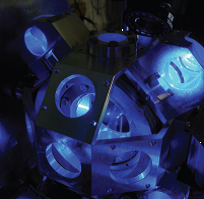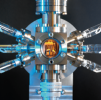WP1 Local frequency comparisons and absolute frequency measurements

Workpackage leader: Dr Rachel Godun, NPL
Other participants: INRIM, VTT, OBSPARIS, PTB, CNRS
The aim of this workpackage was to assess the performance of optical clocks by comparing them locally with other optical clocks being developed within the same national measurement institute (NMI). Comparing the clocks under local laboratory conditions using femtosecond optical frequency combs leads to the highest possible levels of stability and accuracy for the measurements.
Two types of measurement were performed:
- Measurements of optical frequency ratios between optical clocks operating at different frequencies;
- Absolute frequency measurements relative to local caesium-fountain realisations of the SI second.
Optical frequency ratio measurements
The local optical frequency ratios that were measured during the project involved all the operational optical clocks at NPL, OBSPARIS and PTB, i.e. the 199Hg, 87Sr, 88Sr+, 171Yb and 171Yb+ (E2 and E3) standards. All except for the 199Hg standard have already been accepted as secondary representations of the second and the measurements performed in this project will make a significant contribution to assessing their performance as candidates for a future redefinition of the second.
A particular highlight amongst the local optical frequency ratio measurements performed is the measurement of the 199Hg / 87Sr optical frequency ratio at OBSPARIS. The fractional uncertainty of this measured frequency ratio is 1.8×10-16, and is dominated by the systematic uncertainty of the 199Hg lattice clock, with the 87Sr lattice clock contributing only 4.1×10-17. The result is in good agreement with an independent measurement performed at RIKEN in Japan, and is the first inter-continental agreement between optical frequency ratio measurements with an accuracy beyond that of the realization of the SI second.
Absolute frequency measurements
Absolute frequency measurements of all the operational optical atomic clocks at INRIM, NPL, OBSPARIS and PTB, i.e. the 199Hg, 87Sr, 88Sr+, 171Yb and 171Yb+ (E2 and E3) standards, were performed during the project. In most cases the measurement uncertainties reached the low parts in 1016 level, limited by the uncertainties of the caesium fountain primary frequency standards that were used as local realisations of the SI second in each laboratory.
Where possible, independent absolute frequency measurements were made at more than one institution to check the consistency. For example, five independent absolute frequency measurements of 87Sr optical lattice clocks were performed, with agreement being observed between the different clock designs at PTB, OBSPARIS and NPL to the level at which the SI second can be realised. In the case of the 87Sr system at NPL, the clock was operated and its uncertainty evaluated for the first time during the project.
A second new clock also came into operation during the project. This was the 171Yb optical lattice clock at INRIM. For this system the absolute frequency measurement reached the 10-15 level of fractional uncertainty, but with prospects for significant further improvement, since the local caesium primary frequency standard IT-CsF2 has been evaluated to 2×10-16.
Both the optical frequency ratio and absolute frequency measurement results fed into the frequency ratio matrix analysis that was performed in WP5 to check the self-consistency of the measurements and to generate optimised values of the transition frequencies for the new generation of optical clocks.

The research within this EURAMET joint research project receives funding from the European Community's Seventh Framework Programme, ERA-NET Plus, under Grant Agreement No. 217257.

